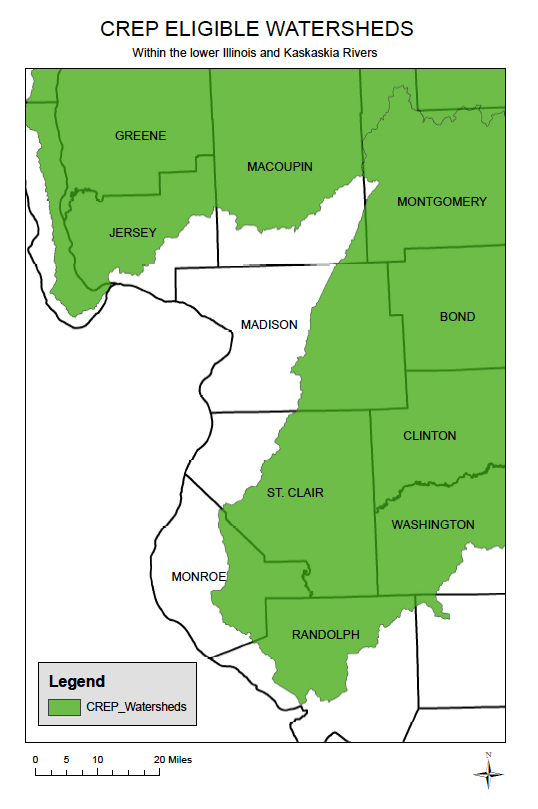Article by: Louise Jett, ljett@lc.edu
MADISON COUNTY – Due to the recent passage of the 2014 Farm Bill, several land conservation opportunities for rural landowners have re-opened, including the Conservation Reserve Program (CRP) and Conservation Reserve Enhancement Program (CREP).
Local landowners interested in learning about these land conservation opportunities are invited to join the Madison County Soil and Water Conservation District during one of two meetings, which will be held from 9-10 a.m. and 7-8 p.m. Wednesday, July 9, at the SWCD office, located at 7205 Marine Road in Edwardsville. Both meetings will cover the same topics and feature light refreshments.
CRP gives landowners the opportunity to receive a guaranteed payment during a contract of up to 15 years for replacing crops on marginally productive and environmentally sensitive ground with conservation practices. These practices can include planting trees, native grasses and/or flowers, creating natural habitat buffers on the edges of fields and streams and restoring wetland areas.
Signup for the CRP opened June 9. This current round, known as Continuous Signup, is focused on environmentally sensitive croplands, wetlands, areas adjacent to streams or rivers, and cropped areas susceptible to erosion.
“These programs are beneficial in that they give landowners guaranteed income for the length of the contract on cropland acres that may flood frequently, reducing their risk of loss,” said Rick Macho, resource conservationist at the Madison County Soil and Water Conservation District. “They also provide excellent habitat for wildlife, prevent erosion and keep nutrients out of our waterways.”
The Conservation Reserve Enhancement Program (CREP) is an offshoot of CRP. CREP, which is a partnership between federal, state and local units of government, provides a unique opportunity by allowing landowners with some of the most environmentally sensitive floodplain lands to voluntarily enroll acres in conservation practices and receive additional financial incentives. This program provides landowners the option and incentives to set aside conservation acres with 15-year, 35-year, or perpetual conservation easements.
On eligible acres, the CREP program stacks the annual payments of a 15-year federal CRP contract with an additional upfront payment from the state. In addition, the landowner may receive a reimbursement for up to 50 percent of the cost of installing the conservation practices.
“The combination of federal and state incentives can give landowners a guaranteed stream of income for up to 15 years, while also providing a nice upfront payment to set aside acreage that ought to be in conservation,” said Jake Hendee, agricultural conservation programs manager for the National Great Rivers Research and Education Center (NGRREC) in East Alton. “We’ve seen landowners use these financial incentives from enrolling acres in CREP to acquire more land to put into conservation practices.”
In addition to financial incentives, CREP is popular with landowners because it establishes additional wildlife habitat for hunting and opportunities for other recreation while they also know they’re leaving a legacy of wildlife habitat and environmental protection.
To be eligible for the Illinois CREP program, lands must be within the Illinois River or Kaskaskia River watersheds (including tributaries of these rivers). Some or all of the cropland must be in the designated 100-year floodplain. Other adjacent highly erodible cropland, wetlands, prior converted wetlands or wetlands farmed under natural conditions may also be eligible.
To determine eligibility, landowners can contact their local Soil and Water Conservation District. A directory of districts can be found at www.aiswcd.org/your-district.
NGRREC also has personnel working with the Illinois Department of Natural Resources and the U.S. Department of Agriculture to assist landowners in signing up for these programs.
“If a landowner is interested in the program, I’d encourage them to either contact me or their local Soil and Water Conservation District to confirm eligibility, and we can offer more details on the program and provide an estimate of the incentives the landowner will receive, and ultimately help them navigate the signup process,” said CREP Land Conservation Specialist Elisa Royce.
For additional information, Royce can be reached at (618) 468-2831 or eroyce@lc.edu.